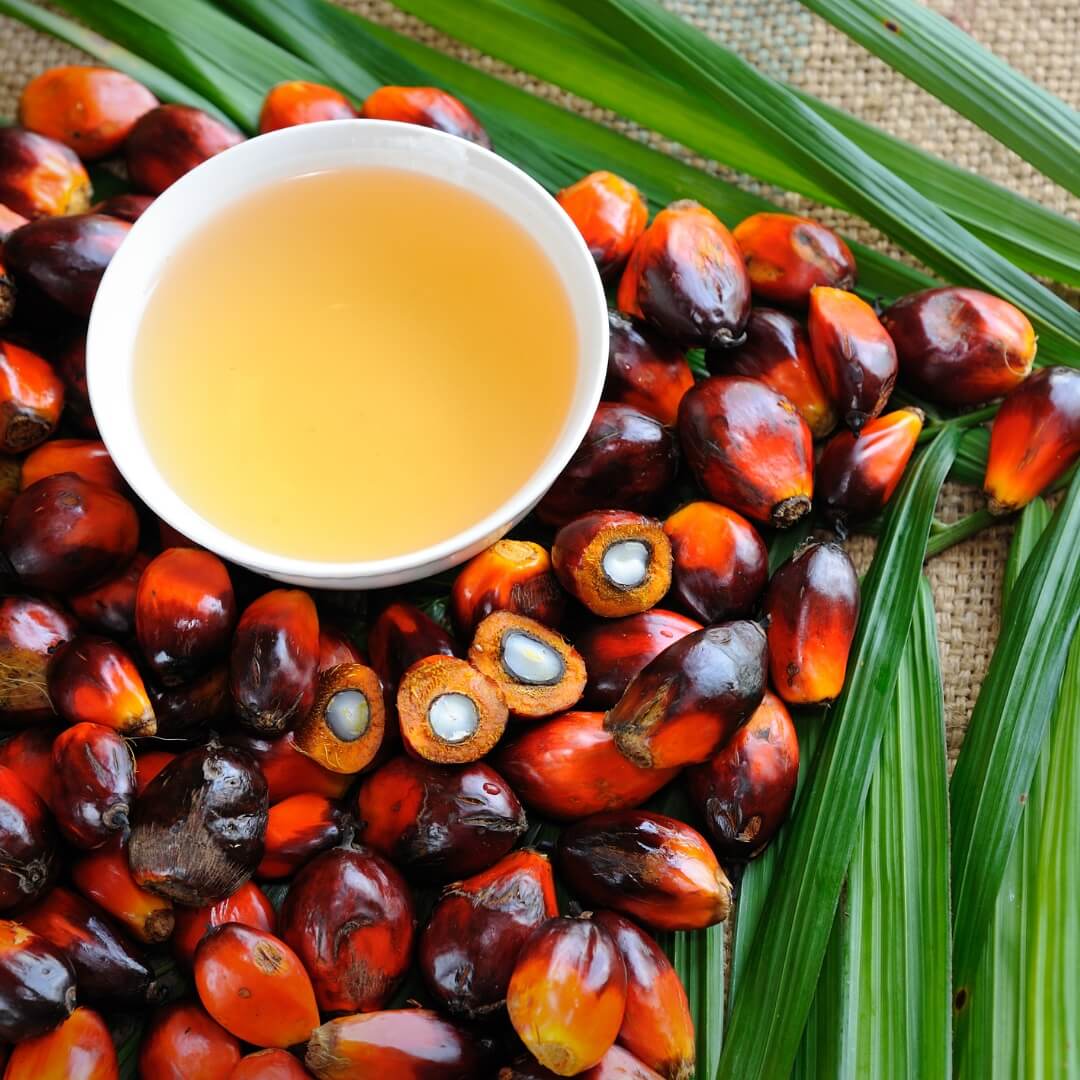Ingredient Spotlight: Palm Oil
Posted by Naturally Safe Cosmetics on 11th Aug 2021
3 1/2 minute read
In recent years, one of the most controversial ingredients found in everyday products has to be Palm Oil. So, what is palm oil, why is it such a popular ingredient in just about everything and why are so many people against it?
What is Palm Oil?
Palm Oil is an edible vegetable oil derived from the fruit of the oil palm tree. Two types of oil can be produced from this fruit – crude palm oil which comes from squeezing the fleshy fruit and palm kernel oil which comes from crushing the kernel (stone) in the middle of the fruit. Best suited to warm, humid climates and originating from West Africa, the oil palm tree is now grown throughout the world. Palm Oil accounts for around 35% of the world’s vegetable oil production.
Which products contain Palm Oil?
Palm Oil is used in a vast array of products including food items, beauty and personal care products and as biofuel for motor vehicles, shipping and aircraft. In fact, it is estimated that Palm Oil can be found in around 50% of products which consumers purchase and use on a daily basis! India, China, Indonesia and Europe are the biggest consumers of Palm Oil.
Why is Palm Oil so popular?
Palm Oil is popular for a number of reasons. When it comes to food items, Palm Oil has great cooking properties. It has a smooth, creamy texture and no smell, making it an ideal ingredient in many recipes. It can extend the shelf life of food products with its natural preservative effect. It is efficient and inexpensive because it is the highest yielding vegetable crop, needing less than half the land required by other crops to produce the same amount of oil.

Palm Oil. Image source: Canva
Why does Palm Oil have a bad reputation?
Palm Oil production is said to be responsible for a large amount of deforestation which in turn destroys habitats and contributes to climate change. In addition, Palm Oil refineries contain ponds of wastewater which release huge amounts of the greenhouse gas Methane.
Apparently, Palm Oil trees grow best on land that has not been previously used for agriculture, so primary rainforests are often cleared to make room for expanding palm plantations. This is done through burning and these fires also emit large amounts of harmful smoke and greenhouse gases. On top of that, the primary rainforests targeted for Palm Oil plantations usually sit on top of peat bogs which store more carbon dioxide than any other ecosystem in the world. When burned, this also releases large amounts of carbon dioxide, producing pollution and smog.
Palm Oil production is considered to be a major cause of climate change and global warming and Indonesia is now responsible for the third highest level of greenhouse gas emissions worldwide as a result of deforestation for Palm Oil.
Then we have the orangutans
Deforestation destroys the orangutans' habitat, leaving them with nowhere to live. Displaced and confused, with no source of food, they reportedly either starve to death or wander into the Palm Oil plantations where they are often killed by workers or taken by poachers. According to the Orangutan Foundation, anywhere between 1,000 and 5,000 orangutans are killed every year as a result of Palm Oil production.
What about alternatives?
Palm trees produce 4-10 times more oil than other crops per unit of cultivated land. So, replacing Palm Oil with other vegetable oils would mean larger amounts of land would need to be used, creating similar or perhaps even larger environmental and social problems.
In addition, around 4.5 million people in Indonesia and Malaysia earn their living from Palm Oil production. The halting of production altogether would result in significant problems for farmers and their families who support themselves through the Palm Oil industry.
When it comes to food, it is considered that replacement oils would not give the same texture and taste offered by palm oil.
What about sustainability?
Sustainable Palm Oil refers to Palm Oil that is produced in accordance with criteria designed to minimise the negative impacts of Palm Oil cultivation on the environment and communities where it is produced.
In 2004, the Roundtable on Sustainable Palm Oil (RSPO) was established with the objective of transforming markets to make sustainable Palm Oil the norm. The RSPO is a not-for-profit entity uniting stakeholders from 7 sectors of the Palm Oil industry to develop and implement global standards for sustainable Palm Oil. There are more than 4,000 members worldwide, representing all links along the Palm Oil supply chain from oil producers to manufacturers of consumer products, bankers/investors and environmental and non-governmental organisations.
The RSPO has established a set of environmental and social criteria which companies must comply with in order to produce what is known as Certified Sustainable Palm Oil.
The RSPO believes Sustainable Palm Oil is the solution to the Palm Oil problem because it:
- fulfils increasing global food demand
- supports affordable food prices
- supports poverty reduction
- safeguards social interests, communities and workers
- protects the environment and wildlife
How is Palm Oil listed on product packaging?
Sometimes, it is simply listed as Palm Oil but there are numerous other descriptions to be found on product packaging for Palm Oil and its derivatives. These include: Palm Fruit Oil, Palm Kernel, Palm Kernel Oil, Palmate, Palmitate, Palmitic Acid, Sodium Kernelate, Palmityl Alcohol, Palm Seed Oil and more.
Naturally Safe Cosmetics favours brands that do not use Palm Oil in their formulations or use only sustainably sourced Palm Oil and/or its derivatives.
Sources: wwf.org.uk: ensia.com; foodstandards.gov.au; orangutanfoundation.org.au; rspo.org


